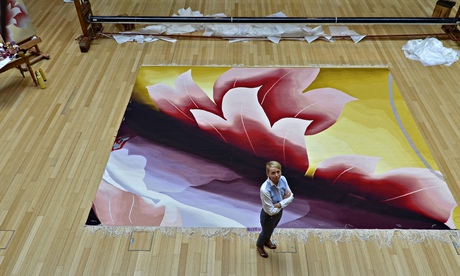
I didn’t expect to fall in love with the sound of it. The sound of the making of a tapestry. Dovecot Studios in Edinburgh, the oldest practising tapestry studio in the country, is housed in a site that was formerly the first public baths in the city and has better acoustics than most concert venues. Now, instead of the sound of splashing and the laughter of children, it’s the gentle tamping of weft that rises and reverberates from beneath the great ceiling.
When I was commissioned to make a “cartoon” (a design) for a monumental artwork to be made here, I had no idea that the creation of this vast woven surface, a process virtually unchanged for centuries, would have its own score. As soothing as the ticking of a clock, it’s a soundtrack that would calm me over the nine months I watched its shifting progress on the gigantic ash loom, which dominated what used to be the deep end of the pool.
There, I spent as much time listening as I did looking. I know now that a tapestry contains its own music. From the first, as almost 2,000 lengths of wool (warps) are stretched taut on the loom like great guitar strings, to the rhythmic rippling of the wooden bobbins, delicate as wind chimes as the tapestry is wound down to retain its tension.
Scottish Opera commissioned me to design the piece, and Madama Butterfly was my inspiration. It was the first opera its founder, Sir Alexander Gibson, conducted for them, and also his last. It was one of his favourite operas… and mine. I wanted to create a piece that echoed the drama and atmosphere experienced through its live performance.
I remembered how it felt to watch Madama Butterfly. Its vividness, its visceral impact, and I wondered if it was possible to create an emotional landscape through the artwork itself – to evoke the love and loss contained within the music, not only through composition but through colour.
Head weaver Naomi Robertson and I discussed colour for months. We dissected the colours that would be used in the tapestry, tried to discover their essence. Almost like the making of a pointillist painting, each colour had to be meticulously broken down before weaving could start. Samples were made and pored over in order to create not just form but also a feeling… a mood through the use of colour.
Watching the weavers bring the tapestry into being was extraordinary, but it was only when it was all over that I realised how much I missed listening to them.
Back in my studio, I think of how weaving differs from painting. Once weaving starts, decisions made are final (hence the lengthy preparations). It seems so obvious to me now but if you want to change an earlier section of a tapestry, everything has to be unpicked. When I make a painting, it involves slowly building up layer upon layer of paint. Think of the x-rays you see of a cross-section of an old master painting: it looks almost like a sandwich.
Within those layers, you are often making modifications, some subtle, some radical, guided by how the paint itself dries. Weeks and months are organised around something you have little control over, the behaviour of the paint. It’s an evolution that is rarely revealed to the viewer, except through the passage of time.
It’s known as pentimento, the beautiful Italian word for repentance. Pentimenti are the alterations in a painting that become apparent through traces of previous workings. In historical painting, we might see the differing positions of a head. A faint third hand, perhaps. Wonderfully, the thoughts of an artist long dead can sometimes unfold in front of us.

